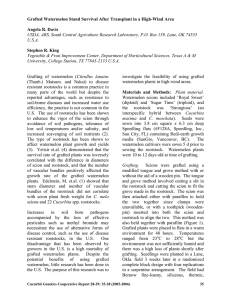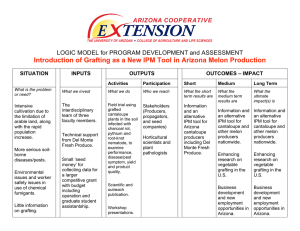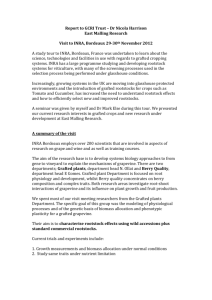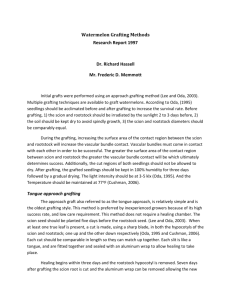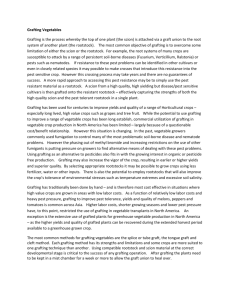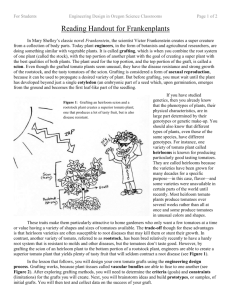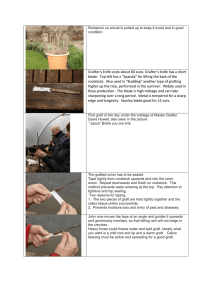Systematic Studies on the Family Cucurbitaceae of Eastern Bihar
advertisement
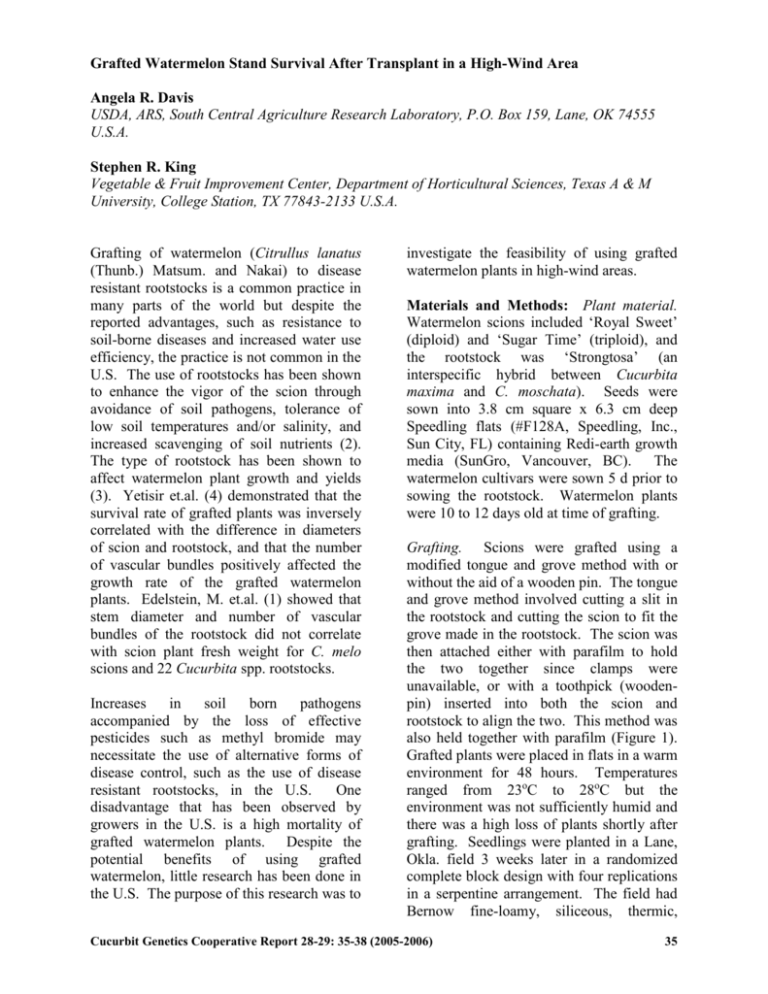
Grafted Watermelon Stand Survival After Transplant in a High-Wind Area Angela R. Davis USDA, ARS, South Central Agriculture Research Laboratory, P.O. Box 159, Lane, OK 74555 U.S.A. Stephen R. King Vegetable & Fruit Improvement Center, Department of Horticultural Sciences, Texas A & M University, College Station, TX 77843-2133 U.S.A. Grafting of watermelon (Citrullus lanatus (Thunb.) Matsum. and Nakai) to disease resistant rootstocks is a common practice in many parts of the world but despite the reported advantages, such as resistance to soil-borne diseases and increased water use efficiency, the practice is not common in the U.S. The use of rootstocks has been shown to enhance the vigor of the scion through avoidance of soil pathogens, tolerance of low soil temperatures and/or salinity, and increased scavenging of soil nutrients (2). The type of rootstock has been shown to affect watermelon plant growth and yields (3). Yetisir et.al. (4) demonstrated that the survival rate of grafted plants was inversely correlated with the difference in diameters of scion and rootstock, and that the number of vascular bundles positively affected the growth rate of the grafted watermelon plants. Edelstein, M. et.al. (1) showed that stem diameter and number of vascular bundles of the rootstock did not correlate with scion plant fresh weight for C. melo scions and 22 Cucurbita spp. rootstocks. Increases in soil born pathogens accompanied by the loss of effective pesticides such as methyl bromide may necessitate the use of alternative forms of disease control, such as the use of disease resistant rootstocks, in the U.S. One disadvantage that has been observed by growers in the U.S. is a high mortality of grafted watermelon plants. Despite the potential benefits of using grafted watermelon, little research has been done in the U.S. The purpose of this research was to investigate the feasibility of using grafted watermelon plants in high-wind areas. Materials and Methods: Plant material. Watermelon scions included ‘Royal Sweet’ (diploid) and ‘Sugar Time’ (triploid), and the rootstock was ‘Strongtosa’ (an interspecific hybrid between Cucurbita maxima and C. moschata). Seeds were sown into 3.8 cm square x 6.3 cm deep Speedling flats (#F128A, Speedling, Inc., Sun City, FL) containing Redi-earth growth media (SunGro, Vancouver, BC). The watermelon cultivars were sown 5 d prior to sowing the rootstock. Watermelon plants were 10 to 12 days old at time of grafting. Grafting. Scions were grafted using a modified tongue and grove method with or without the aid of a wooden pin. The tongue and grove method involved cutting a slit in the rootstock and cutting the scion to fit the grove made in the rootstock. The scion was then attached either with parafilm to hold the two together since clamps were unavailable, or with a toothpick (woodenpin) inserted into both the scion and rootstock to align the two. This method was also held together with parafilm (Figure 1). Grafted plants were placed in flats in a warm environment for 48 hours. Temperatures ranged from 23oC to 28oC but the environment was not sufficiently humid and there was a high loss of plants shortly after grafting. Seedlings were planted in a Lane, Okla. field 3 weeks later in a randomized complete block design with four replications in a serpentine arrangement. The field had Bernow fine-loamy, siliceous, thermic, Cucurbit Genetics Cooperative Report 28-29: 35-38 (2005-2006) 35 glossic palendalf soil. There were no wind breaks in the field. Survival counts were taken prior to transplanting in the field, and at 3 d and 10 d after transplanting. Statistics. Means were calculated for grafting frequency by dividing the number of graft attempts by successful grafts (prior to transplanting) for each variety and method. Three and ten day survival frequencies were calculated by dividing number of transplants surviving after 3 d or 10 d by the number of transplants for each treatment. Analysis of variance was performed using Proc GLM with mean separation by Duncan’s multiple range test (SAS statistical software, Cary, NC). Results and Discussion: The wooden-pin modification of the tongue and groove method did speed the grafting process compared to the non-modified method because the toothpick provided sufficient support. Survival of the tongue and groove and wooden-pin modified tongue and groove method were similar, ranging from 33 to 40% success (Table 1), which indicates that the wooden-pin modification did not hinder the healing process. Both methods were similar for transplant survival after 3 days with a range from 70 to 83%. However, Sugar Time had a lower survival rate (24 to 37%) at day 10 than Royal Sweet (67 to 69%). This may be due to smaller seedling size at time of grafting compared to Strongtosa reducing graft acceptance. Survival of the grafted plants was significantly reduced when compared to the respective survival of non-grafted plants. The primary cause of transplant loss appeared to be tissue breakage at the graft union. Wind conditions in Lane following transplanting had gusts up to 32 mph (Table 2). Very few plants were lost after the 10 day stand count The goals of any grafting modifications should be to reduce input costs and increase survivability in the field. The methods used 36 here did not show significantly different changes in survivability, but the wooden-pin method did decrease the amount of time required to perform the grafts, which will result in lower costs. However, it appears the added support afforded by the woodenpin modified method will not result in increased survival of grafted watermelon plants under high wind conditions. Further study is needed with multiple rootstock/ scion combinations and grafting techniques to determine optimal survival rates of grafted plants under high-wind conditions. Literature Cited: 1. Edelstein, M., Y. Burger, C. Horev, A. Porat, A. Meir, and R. Cohen. 2004. Assessing the effect of genetic and anatomic variation of Cucurbita rootstocks on vigour, survival and yield of grafted melons. J. Hort. Sci. Biotech. 79:370-374. 2. Ruiz, J. M., A. Belakbir, I. LopezCantarero, and L. Romero. 1997. Leafmacronutrient content and yield in grafted, melon plants. A model to evaluate the influence of rootstock genotype. Scientia Hort. 71:227-234. 3. Yetisir, H., and N. Sari. 2003. Effect of different rootstock on plant growth, yield and quality of watermelon. Australian J. Expt. Agr. 43:1269-1274. 4. Yetisir, H. and N. Sari. 2004. Effect of hypocotyl morphology on survival rate and growth of watermelon seedlings grafted on rootstocks with different emergence performance at various temperatures. Turkish J. Agr. For. 28:231-237. Disclaimer: Mention of trade names or commercial products in this article is solely for the purpose of providing specific information and does not imply recommendation or endorsement by the U.S. Department of Agriculture. All programs and services of the U.S. Department of Agriculture are offered on a nondiscriminatory basis without regard to Cucurbit Genetics Cooperative Report 28-29: 35-38 (2005-2006) race, color, national origin, religion, sex, age, marital status, or handicap. The article cited was prepared by a USDA employee as part of his/her official duties. Copyright protection under U.S. copyright law is not available for such works. Accordingly, there is no copyright to transfer. The fact that the private publication in which the article appears is itself copyrighted does not affect the material of the U.S. Government, which can be freely reproduced by the public. Acknowledgments: We would like to thank Anthony Dillard, Amy Helms, and Ashley Gammon for providing valuable technical support. Special thanks go to Tom Williams and Glen Price for supplied seed. Table 1. Comparison of grafting frequency and transplant survival frequency for the different cultivars and different grafting methods. Variety Royal Sweet Royal Sweet Royal Sweet Method Parafilm Toothpick Non-grafted % Graft survival* 26 33 NA Number of transplants 26 33 33 % 3d Survival** 83b 83b 100a % 10d Survival** 69b 67b 91a Sugar Time Sugar Time Sugar Time Parafilm Toothpick Non-grafted 30 29 NA 30 29 33 70b 73b 98a 37b 24b 98a *% Graft survival = (successful grafts/attempted grafts) x 100. One hundred graft attempts were made for each treatment. There were no significant differences at the P0.05 level of probability. **Percentage of plants surviving 3 and 10 days after transplanting. Means followed by the same letter are not significantly different at the P0.05 level of probability. Table 2. Wind speed weather data for 10 days following transplanting. Days after transplant 0 1 2 3 4 5 6 7 8 Average (mph) 5 8 5 9 8 9 8 7 6 Gust (mph) 18 27 32 22 19 20 21 24 20 9 10 8 6 20 16 Cucurbit Genetics Cooperative Report 28-29: 35-38 (2005-2006) 37 Figure 1. The toothpick modified tongue and groove graft procedure. A groove is made in the rootstock and a tongue is made in the scion to fit the groove. For the modification a toothpick is inserted into the rootstock and the scion is inserted onto the toothpick and pressed down to make contact with the rootstock. Parafilm was used to hold the graft in place. 38 Cucurbit Genetics Cooperative Report 28-29: 35-38 (2005-2006)
